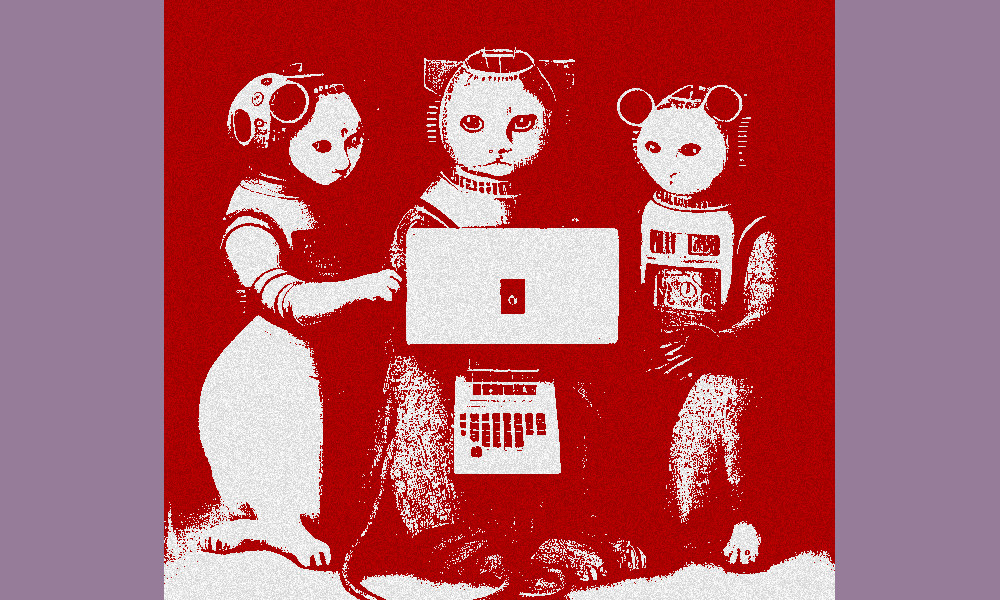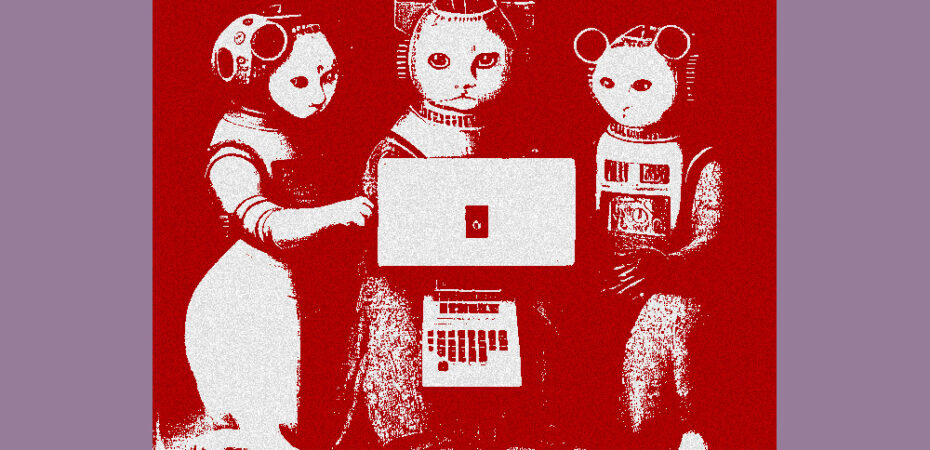
In part one of a two-post series, Vassilis Galanos discusses attempts at using ChatGPT in the classroom and for essay writing and reflects on the software’s limitations but also why it can be seen as an indicator of broader social challenges in education and beyond. This post belongs to the Hot topic series: Moving forward with ChatGPT.
I. Holy Automation, Holy Job Losses, Holy Hidden Work, ChatGPT we rename thee.
Does it matter whether the following text has been produced by a machine? It matters when teaching matters are at stake. OpenAI’s GPT-3, GPT-4, and ChatGPT are online artificial intelligence (AI) software that generate original, in terms of predictability and detectability, text by “transforming” material from existing databases according to pre-trained variables (hence the acronym Generative Pre-trained Transformer). They have been widely discussed across academic circles within The University of Edinburgh but also across online fora, such as Twitter, for their potential impact on essay-based and other written teaching assessments because of some impressively satisfying functions: prototyping text, summarising paragraphs, providing lists of sources, writing code, even suggesting essay marks. Like with previous computational techniques attached to educational purposes (computer-aided design, spellcheck, text prediction, Wikipedia articles, search engines), Generative AI applications’ use in education carries all bias bugs baggage of algorithmic persuasion and convincing power (Little Britain: “the computer says no!”) of either ultimate rationality of the computer programme or wisdom of the crowds (what others have also searched/confirmed).
I teach courses about the sociology and politics of the internet and artificial intelligence (AI) at the School of Social and Political Science while I recently released my PhD thesis on historical and current views on AI expectations. Hence, I felt I should write a few words on teaching with/without ChatGPT or other large language model (LLM)-based applications. For those well versed in AI, these are ancient mantras reiterated with finer nuance. In any event, I promise a few practical suggestions, and a couple of Kraftwerk references.
As usual with all computer- and AI-related innovations, the landscape is divided between enthusiasts (see for example, Adiguzel et al 2023) and doomsayers, with some sceptics navigating between the utopian Scylla and dystopian Charybdis. Educators tend to fall on the second category given the software’s admittedly impressive performance in producing text that can pass a mild “Turing Test”: it appears critically and academically informed, as if written by a human, at first glance at least. That “first glance” is important. It is telling of an academic culture that demands from students to write more essays, blogposts, and other written exams (read: “produce more text”) in shorter time intervals, and educators, teaming up with mighty digital plagiarism detectors, to assess them at ever-growing speed – at least, if they want to squeeze some time to produce more text for their academic development (journal articles, research reports, other administrative documents). Paul Virilio would call this “turbocapitalism”; Knut H. Sørensen and Sharon Traweek might situate this within the context of “academic capitalism” in “questing excellence in academia.”
II. ”We are the Robots” or “We are the Robots”?
First Kraftwerk reference. In their 1978 song We Are the Robots, techno-pop band Kraftwerk repeat the phrase “we are the robots” 32 times without stressing any of the words (with ambiguity being their defining characteristic; Schüte 2020). Most listeners interpret the song by imagining the stress being on “robots,” implying that nonhuman robots (read: ChatGPT-like software) are declaring their existence and come to take over human jobs, legal rights, consciousness, and any precious, socially constructed anthropocentric value that makes humans unique. That is the doomsayers’ version. The sceptics’ version emerges in the listener’s mind if stress is placed on “we.” Keeping up with early 20th century metaphors about robots, from Karel Čapek’s 1920 theatrical play R.U.R. (Rossumovi Univerzální Roboti, or, Rossum’s Universal Robots) to Thea von Harbou and Fritz Lang’s film Metropolis, Kraftwerk play on the ambiguity that the possibility of creating artificial slaves confirms workers’ (including academic workers) potential slave or artificiality status. Kraftwerk’s retrofuturistic irony did not allow for an enthusiasts’ version, and that’s what makes them a cool band.
Indeed, if societal standards for assessing essay quality and integrity are mechanised, then we can teach replicator machines to replicate them and produce similar ones. Before ChatGPT’s release, I have marked many students essays (and have been paid to produce many reports) that could have passed the test for being produced by a machine if inspected in light of LLMs. Generative AI reminds us that errors, as defined by learning expectations, are signs of creativity; while creativity often occurs by errors. Both movements form an alliance against the misery of being average. To be statistically predictable and replicable is to be average. To get an “average” score in Edinburgh’s social science (65/100) is to write statistically probable essays. That is a job that can be performed either:
(a) by students who learn how to feed a social machine that produces and demands “the” average,
(b) by other humans who learn how to replicate this writing style in order to get paid (informally) by students who want to match the averageness standard, and in part nowadays,
(c) by mechanic assistance that based on a vast amounts of examples can produce, if prompted, average-like text. That is something that extensive use of ChatGPT may achieve if used without sufficient creative thinking: a mid- or lower average mark that satisfies everyone’s unspoken realisation that universities (might) turn into machines producing the average.
That is what Jean Baudrillard, via Walter Benjamin, would call lack of “aura” in the context of human culture’s mechanical reproducibility. A student wrote an essay in pompous defence of ChatGPT’s functions for essay polishing, starting with the useful hypothesis that ChatGPT merits credence for essay assistance in English-speaking universities, especially for students who are not native English speakers. The essay would not score very high normally: it was complete with typos, grammatical/citation style mistakes, lack of course-related resources, disconnected arguments. I left the following comment after a very optimistic introduction in which the student committed the typical citation sin of adding an author’s first name initials after the surname: “GPT probably didn’t help you get rid of superfluous initials in in-text citation! Therefore I can still tell that a human has written this.” Because of the attempt, however, the student’s honesty, and the will to experiment, the essay received a higher mark for its originality. Originality, after all, can be viewed as the ability to err in a creative way. The aura of erriginality, if I may.
ChatGPT teaches us in this case the difference between creative error and algorithmic glitch – sometimes the difference is subtle, even inconceivable, but nevertheless important. Remember Heidegger: one experiences the existence (dare I: essence) of a technology when it breaks down – and we will be able to go beyond LLMs once we experiment enough, identify its glitches, separate them from the beauty of human error, and consider its practical utility as a tool. Some of us even refuse to use spellcheck, after all.
This brings me to a practical recommendation to assess student performance that is occasioned by ChatGPT but invites creativity – and is an extension of the, now normalised, “I am not a robot” online security tests: I would challenge students and educators altogether to compose essays and design learning objectives and forms of assessment that demonstrate sufficient inventiveness that cannot be mimicked by machines. (The very word “objective” is problematic, when learning is meant to have subjective value.) To me, it is no coincidence that Cormack McCarthy’s latest novel Stella Maris contains multiple references to the 1970s conversational programme ELIZA, trained to respond like a psychoanalyst; three times in the novel a psychiatric patient ridicules the psychiatrist by equating his responses to those by ELIZA.
In the next post, I will offer two more recommendations for teaching with and without ChatGPT that can be beneficial towards both helping educators and students understand what LLMs are all about, but also highlight the value of material beyond these models’ radars.
References
- Adiguzel, T., Kaya, M. H., & Cansu, F. K. (2023). Revolutionizing education with AI: Exploring the transformative potential of ChatGPT. Contemporary Educational Technology, 15(3), ep429.
- Baudrillard, J. (1981). Simulacra and Simulation. Ann Arbor: The University of Michigan Press.
- Galanos, V. (2023). Expectations and expertise in artificial intelligence: specialist views and historical perspectives on conceptualisation, promise, and funding. Doctoral Thesis. Edinburgh: University of Edinburgh.
- Joyce, J. (1939[1992]). Finnegans Wake. London: Penguin Books.
- McCarthy, C. (2023). Stella Maris. Gyldendal A/S.
- Mitchell, M., Wu, S., Zaldivar, A., Barnes, P., Vasserman, L., Hutchinson, B., … & Gebru, T. (2019, January). Model cards for model reporting. In Proceedings of the conference on Fairness, Accountability, and Transparency, Association for Computing Machinery (pp. 220-229).
- Schüte, U. (2020). Kraftwerk: Future Music from Gernamy. Great Britain: Penguin Books.
- Sørensen, K. H., & Traweek, S. (2022). Questing Excellence in Academia: A Tale of Two Universities (p. 236). Taylor & Francis.
- Turkle, S. (1980). Computer as roschach. Society, 17(2), 15-24.
- Virilio, P. (2012). The Great Accelerator. Translated by Julie Rose. Cambridge and Malden: Polity.
 Vassilis Galanos
Vassilis Galanos
Vassilis Galanos (it/ve/vem) is a Teaching Fellow in Science, Technology and Innovation Studies at the School of Social and Political Science, University of Edinburgh and associate editor of the journal Technology Analysis and Strategic Management. Vassilis researches and publishes on the interplay of expectations and expertise in the development of AI, robotics, and internet technologies, with further interests in cybernetics, media theory, invented religions, oriental and continental philosophy, community-led initiatives, and art. Vassilis is also a book, vinyl, beer cap, and mouth harp collector – using the latter instrument to invite students back from class break.
Twitter handle: @fractaloidconvo


